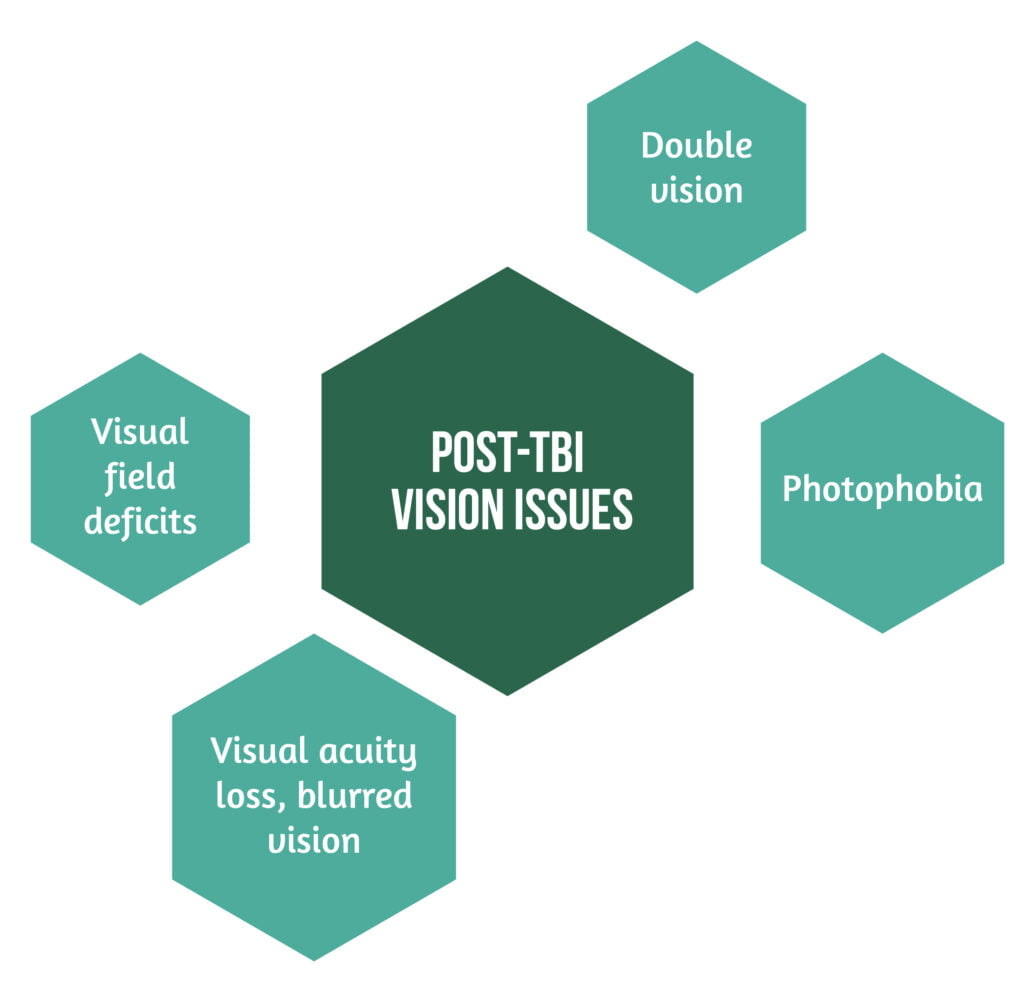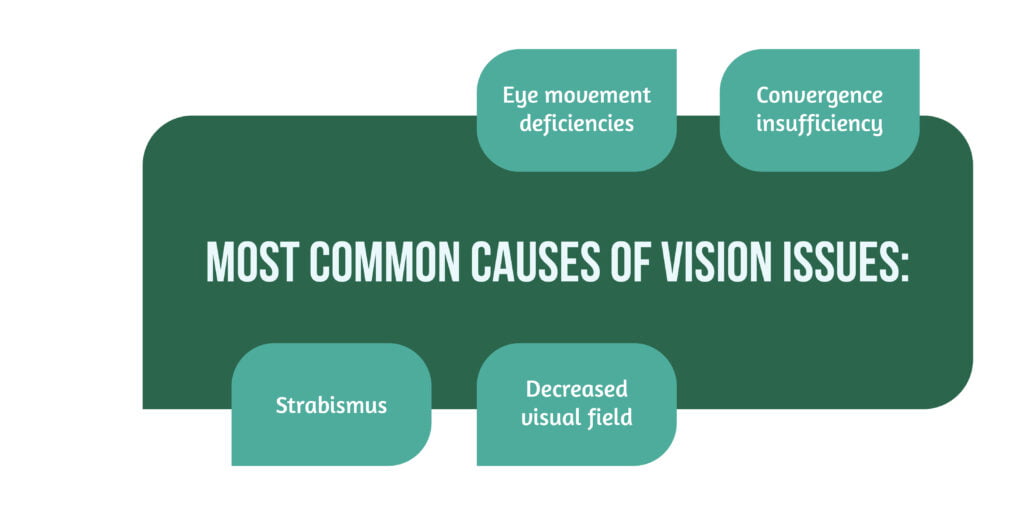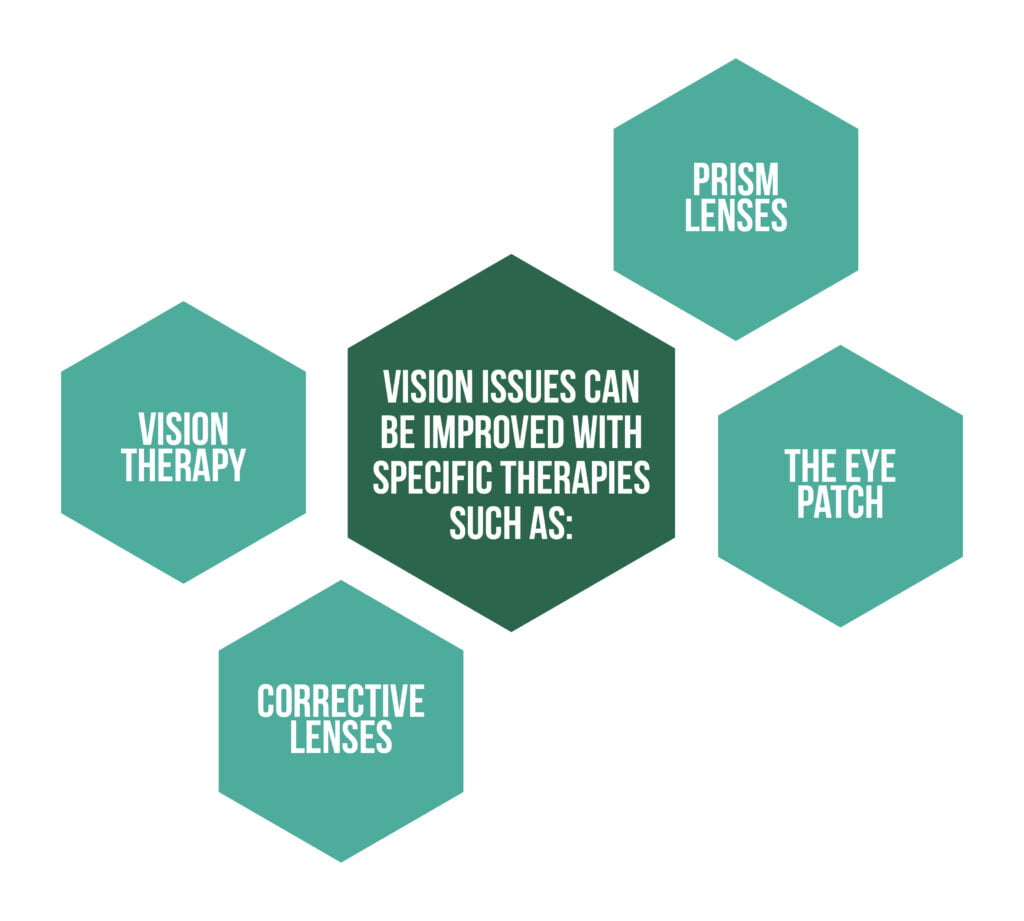Keywords: vision problems, photophobia, diplopia
Introduction | Can TBI affect vision?
Vision is one of the most important senses for humans, but also for animals because it helps us to do our daily activities (e.g. reading, driving, going to school or job) and it is an essential system that influences the other body systems function. Without sight, the ability to move would be severely limited, but also the ability to make decisions and think would be affected [1].
Patients with TBI can experience vision disturbances such as visual acuity and visual field deficits, blurred vision, tired eyes, photophobia, double vision, and nystagmus [2]. TBI can affect the eyes, and parts of the brain involved in in visual processing or image perception (optic nerve tract, cranial nerves, occipital lobe) [1].
Eye problems are usually observed by the team care members and patients should be directed to an eye doctor (optometrist, ophthalmologist) who can make a diagnosis and give an appropriate treatment. Neuro-optometrists and neuro-ophthalmologists are also doctors who are trained to treat brain-related vision problems [1, 3].
What are the manifestations of vision problems after TBI?
Vision disabilities occur more frequently after a moderate or severe TBI, but sometimes they are diagnosed later during the recovery process. Some of the vision issues that appear after a TBI are the following [1]:
- Visual acuity loss, blurred vision
- Photophobia- represents abnormal sensibility to light. It can be permanent or appear intermittent.
- Visual field deficits- Patients can experience half peripheral visual field loss (hemianopia) or loss of vision in one-quarter of visual fields (quadrantanopia). Also, some patients experience visual field constriction (tunnel vision) [4].
- Double vision- seeing two images of an object when you are looking at it (Figure 1).

Can visual problems affect your day-to-day life?
Visual problems usually interact with the patient’s daily life and decrease the quality of life. They experience difficulties in reading, driving, or doing other activities. These issues are associated with an increased risk of falls, injuries, or fractures, but also determine poor mental health and social isolation [2].
The most frequent visual changes reported by patients are :
- Objects may appear blurry sometimes or all the time.
- You experience latency when focusing on your gaze when reading.
- It may have the sensation that objects or letters are moving.
- Some patients become nervous in a crowded place or when they see many movements because of visual overload.
- New onset sensibility to light and glare.
- Your eyes can tear up more or feel they are hurt or ache.
- Headaches occur frequently after a TBI. The pain can occur at the site of trauma, but can also have other locations, such as the back of the head, the temples, the forehead, or around the eyes.
- Motion sickness is promoted by a rapid change of focus from close to far objects.
- You can experience difficulties in the perception of the location of the objects in space.
- Visual disabilities affect the ability to perform physical sports [1, 4].
Why do vision problems occur after TBI and what are the manifestations?
Vision issues occur after a TBI because an eye can be damaged during injury or the parts of the brain involved in processing information are affected. Eye problems can also occur without a trauma history, in some eye-related diseases, such as glaucoma, and cataracts [3]. The most common causes of vision troubles are the following:
- Eye movement deficiencies- extraocular muscles are essential in tracking an object and when you want to scan some static objects. Some TBI victims can’t follow a moving object or they are unable to look to one side without rotating their head.
- Convergence insufficiency– Our eyes go inward when an object is moving closer to the nose and they realign when the object goes further. In some TBI patients, their eyes don’t work properly leading to double vision, headaches, and blurred images.
- Strabismus- represents the misalignment of the eyes, both eyes don’t look in the same direction at the same time because of the injury of the nerves which innervate the extraocular muscles.
- Decreased visual field- a part of the visual field is lost. Patients are unable to see above, below, or out to the sides. These changes create significant difficulties in grasping objects and frequent accidents (Figure 2) [1, 2].

TBI is just one of the many diseases that cause vision troubles. The most known causes of blurred vision are stroke, eye infection, diabetes, and hypertension.
What can you do to manage vision problems?
To choose the optimal treatment methods, patients should contact specialists in the treatment of vision disorders after TBI, such as specialized ophthalmologists, optometrists, low vision, and occupational therapists [1].
Vision issues can be improved with specific therapies such as:
- Vision therapy is a common method used usually in children to teach them how to improve visual skills, but nowadays this method is also used for adults with vision dysfunctions. This method’s efficacity is based on the brain’s feature named neuroplasticity (the ability of the brain to change, reorganizing its structure and connections after injury). Optometrists try to ameliorate vision deficits, to develop visual skills by doing exercises, and using lenses, patches, or electronic devices [3, 5].
- Prism lenses are ideal for patients with diplopia, where the light falls in the different parts of the retina, leading to the formation of two images. These lenses make the light fall in the retina’s right part and see clearer image [1].
- Corrective lenses are used for blurry vision and for inability to read or see near and far objects. These lenses make the image bigger and clearer, but usually, people need a different kind of glasses for reading and for looking in the distance, because bifocal lenses are more uncomfortable to use [3].
- The eye patch is a useful method to treat diplopia. The patient should cover the affected eye to eliminate the double image made in the brain. This method can be also used for increasing visual acuity, but for adults, results aren’t guaranteed, in some cases, incorrect patching of the eye can be detrimental to the patient (Figure 3) [1].

What other things can improve visual problems?
Patients with visual problems should visit a doctor to understand how to manage the problem in the right way and how to improve their life quality. There are some things that every patient should know:
- Take short pauses when you do activities that need your eyes to be focused such as reading, working on the computer, sewing, or watching television. You should relax your eyes by watching at a distance (20 feet away) every 20 minutes.
- Magnifying glasses or zooming what you need to read on the computer are essential steps that help you to continue your daily activities properly.
- Increase contrast between objects you use. It will help your eyes to differentiate more easily between light and dark colors.
- Pay attention to what kind of light you use because some lights can be irritating to your eyes (fluorescent light, sunlight). Natural light is more relaxing for your eyes, but wearing sunglasses can be also helpful for your vision.
- Try to avoid visual overload by maintaining a clean and minimalistic way of life. You should put all the necessary objects for a task in the same place, without any additional items. This thing is going to help your eyes from being overwhelmed by so much visual information.
- Respect the hours of rest because sleeping is a good way to rest your eyes and prepare them for everyday activities [1, 2].
Conclusion
After a TBI patients can experience a variety of visual problems which decline their overall health and quality of life. Patients should see a specialized doctor who will help them learn how to adapt their lifestyle in the presence of a disability so that they can continue as many of their previous activities as possible. TBI is a systemic condition for which the TBI victim will require, in addition to the treatment of visual disorders, physical, cognitive, and behavioral therapy to help the patient integrate into society.
For more information about the impact of TBI visit:
- Assessment of Quality of Life after TBI using QOLIBRI-OS
- Can TBI affect taste and smell?
- Mild TBI outcomes – lesssons from the CENTER-TBI study,
We kindly invite you to browse our Interview category https://brain-amn.org/category/interviews/. You will surely find a cluster of informative discussions with different specialists in the field of neurotrauma.
Bibliography
- Vision Problems After Traumatic Brain Injury (TBI). From: https://msktc.org/tbi/factsheets/vision-problems-and-traumatic-brain-injury
- Armstrong RA. Visual problems associated with traumatic brain injury. Clinical and Experimental Optometry. 2018;101(6):716-726. doi:10.1111/cxo.12670
- Russ. Vision and Brain Injuries. Optometrists.org. Accessed November 15, 2023. https://www.optometrists.org/vision-therapy/neuro-optometry/vision-and-brain-injuries/
- Merezhinskaya N, Mallia RK, Park D, Bryden DW, Mathur K, Barker FM. Visual Deficits and Dysfunctions Associated with Traumatic Brain Injury: A Systematic Review and Meta-analysis. Optom Vis Sci. 2019;96(8):542-555. doi:10.1097/OPX.0000000000001407
- russ. What Is Vision Therapy? Optometrists.org. https://www.optometrists.org/vision-therapy/guide-to-vision-therapy/what-is-vision-therapy/




